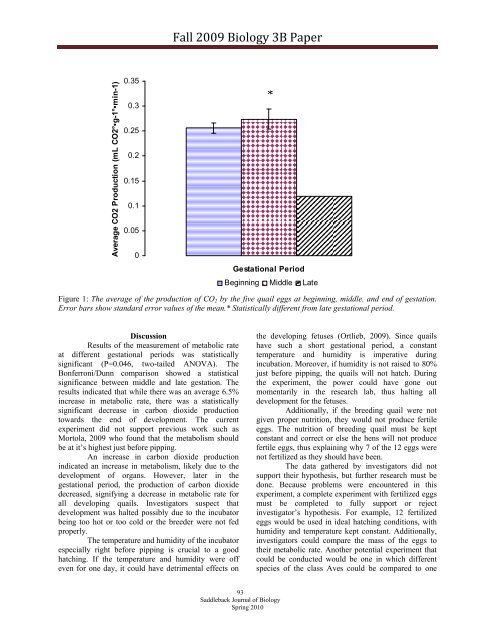Saddleback Journal of Biology - Saddleback College
Saddleback Journal of Biology - Saddleback College
Saddleback Journal of Biology - Saddleback College
Create successful ePaper yourself
Turn your PDF publications into a flip-book with our unique Google optimized e-Paper software.
Fall 2009 <strong>Biology</strong> 3B Paper<br />
Average CO2 Production (mL CO2°•g-1°•min-1)<br />
0.35<br />
0.3<br />
0.25<br />
0.2<br />
0.15<br />
0.1<br />
0.05<br />
0<br />
Gestational Period<br />
Beginning Middle Late<br />
Figure 1: The average <strong>of</strong> the production <strong>of</strong> CO 2 by the five quail eggs at beginning, middle, and end <strong>of</strong> gestation.<br />
Error bars show standard error values <strong>of</strong> the mean.* Statistically different from late gestational period.<br />
Discussion<br />
Results <strong>of</strong> the measurement <strong>of</strong> metabolic rate<br />
at different gestational periods was statistically<br />
significant (P=0.046, two-tailed ANOVA). The<br />
Bonferroni/Dunn comparison showed a statistical<br />
significance between middle and late gestation. The<br />
results indicated that while there was an average 6.5%<br />
increase in metabolic rate, there was a statistically<br />
significant decrease in carbon dioxide production<br />
towards the end <strong>of</strong> development. The current<br />
experiment did not support previous work such as<br />
Mortola, 2009 who found that the metabolism should<br />
be at it’s highest just before pipping.<br />
An increase in carbon dioxide production<br />
indicated an increase in metabolism, likely due to the<br />
development <strong>of</strong> organs. However, later in the<br />
gestational period, the production <strong>of</strong> carbon dioxide<br />
decreased, signifying a decrease in metabolic rate for<br />
all developing quails. Investigators suspect that<br />
development was halted possibly due to the incubator<br />
being too hot or too cold or the breeder were not fed<br />
properly.<br />
The temperature and humidity <strong>of</strong> the incubator<br />
especially right before pipping is crucial to a good<br />
hatching. If the temperature and humidity were <strong>of</strong>f<br />
even for one day, it could have detrimental effects on<br />
the developing fetuses (Ortlieb, 2009). Since quails<br />
have such a short gestational period, a constant<br />
temperature and humidity is imperative during<br />
incubation. Moreover, if humidity is not raised to 80%<br />
just before pipping, the quails will not hatch. During<br />
the experiment, the power could have gone out<br />
momentarily in the research lab, thus halting all<br />
development for the fetuses.<br />
Additionally, if the breeding quail were not<br />
given proper nutrition, they would not produce fertile<br />
eggs. The nutrition <strong>of</strong> breeding quail must be kept<br />
constant and correct or else the hens will not produce<br />
fertile eggs, thus explaining why 7 <strong>of</strong> the 12 eggs were<br />
not fertilized as they should have been.<br />
The data gathered by investigators did not<br />
support their hypothesis, but further research must be<br />
done. Because problems were encountered in this<br />
experiment, a complete experiment with fertilized eggs<br />
must be completed to fully support or reject<br />
investigator’s hypothesis. For example, 12 fertilized<br />
eggs would be used in ideal hatching conditions, with<br />
humidity and temperature kept constant. Additionally,<br />
investigators could compare the mass <strong>of</strong> the eggs to<br />
their metabolic rate. Another potential experiment that<br />
could be conducted would be one in which different<br />
species <strong>of</strong> the class Aves could be compared to one<br />
93<br />
<strong>Saddleback</strong> <strong>Journal</strong> <strong>of</strong> <strong>Biology</strong><br />
Spring 2010

















